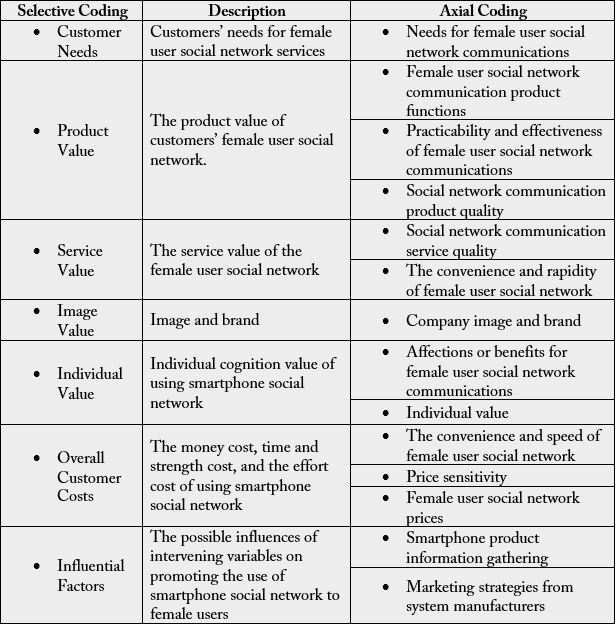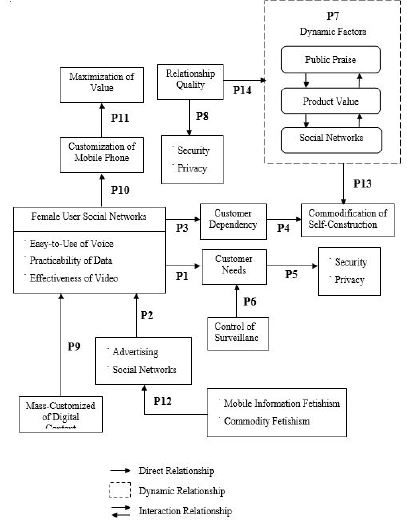Biography
Interests
Yi-Sheng Wang
Associate Professor, Department of Marketing & Distribution Management, Oriental Institute of Technology, Taiwan
*Correspondence to: Dr. Yi-Sheng Wang, Associate Professor, Department of Marketing & Distribution Management, Oriental Institute of Technology, Taiwan.
Copyright © 2018 Dr. Yi-Sheng Wang. This is an open access article distributed under the Creative Commons Attribution License, which permits unrestricted use, distribution, and reproduction in any medium, provided the original work is properly cited.
Abstract
This study began with a microscopic of the smartphone social network services, leading to a comprehensive view of social context. To decompose the female user value in the smartphone social network services, using a three-stage coding process through grounded theory. The contribution of this study is to reveal a theoretically-saturated of a conceptual framework, and to discover the fourteen theoretical propositions.
Introduction
According to the definition by Barnes, Pressey and Scornavacca (2019), smartphone social network services
are the services of delivering data to mobile phones via wireless transmission, such as SMS, e-mail, multimedia
message system, ringtone downloads, news, weather forecasts and stock quotes, etc.
Elhai and Contractor (2018) found that smartphone social network services can deliver very important customer value creation as described in value-based adoption of smartphone social network internet: an empirical investigation.
But there a significant breach of insufficiently and limitation when discussing the micro-view of female user self-consciousness meanings in social network services from the macro view of female user value and social context [1]. Therefore the purposes of this research are: (1) through grounded theory, thoroughly decomposing the meaning of self-subjectivity of the female user in smartphone social network services. (2) building a conceptual framework for the female user social network.
Literature Review
Smartphone social network services became an indispensable technology devices for personal consumption and recreation, even technology jewelry [2]. They are not just a part of many people’s exterior decoration for their functions (PDA, digital camera, MP3, internet, etc.) and appearances can be combined to market different smartphone social network services to different market segments. Furthermore, the use of smartphone social network services also reflexes the differences between social categories or economic groups [3].
The use of smartphone social network services also reflexes the differences between generations (teenagers and youngsters are the main users) [4], classes or income levels (conspicuous consumption for upper-class customers and low subscription rate for lower-class customers) [5], and the differences between genders (special design, production, marketing, and social network services advertisement delivery for female customers, to form female stereotyped impression) and sex appeal [6]. Smartphone social network services are not products of this company or that company, but also socialized products [7]. There are socioeconomic bases for the spread and use of smartphone social network services [8].
New behavior model can also be built with the constraints of social actions and social structure [2]. The contents of value-added social network services, such as color screens or dual screens of multi-media social network [9], polyphonic ringtones, external or internal digital cameras [1], SMS messages, pictures, and other downloads via smartphone social network services [3], have encouraged the rend of smartphone social network capitalism commoditization by helping customers get rid of black-and-white screens and monotone ringtones [2-6].
Research Method
Research objects are selected from Chunghwa Telecom Co., Ltd. (CHT), the telecom company with the largest market share in Taiwan. Theoretical sampling was performed and the smartphone social network service customers were categorized into three groups by their customer values [10]. The first group of respondents includes five people in total: the CHT counter supervisor (F01), the CHT smartphone mobile phone product manager (F02), three mobile phone directors (F03, M04, and F05), the second group of respondents includes six female people in total: an enterprise manager (M06), an enterprise assistant manager (F07), two business owners (M08 and M09), a chairman of the board and a CEO (F10 and M11), and the third group of respondents includes six female people in total: students with age below twenty five (M12, F13, F14, F15, F16, and M17). There are seventeen respondents in total. Semi-structured interviews, recording, and observation were conducted.
The purpose of performing a three-stage coding process through grounded theory is to obtain the text meanings of female user value [11,12]. In order to efficiently deal with a large data set of seventeen respondents, a qualitative coding software package (Nvivo 12) was used for this study to organize and analyze the results from the three-stage coding [13].
To find out female users value concepts in choosing smartphone social network services, open coding was performed on the content of the interviews to define phenomenon and generate concept labels in this study [14]. Then the axial coding was performed after open coding to induce the concepts with the same properties into a higher-level context-bound concept [15]. Besides the factors themselves, the relationships between other factors were also considered when selective coding was performed, in order to achieve the purposes of selective coding in grounded theory [16-18], which are: (1) to build the relationships between categories [19]; (2) To strengthen the proof-concept relationships between [20]; (3) To continuously search for the properties of the main-categories and the sub-categories and to confirm the dimensional locations of the data [7]; (4) To explore and explain proofs in the phenomenon as shown in table 1.

With the assistance of a qualitative coding software package (Nvivo 12), seven text meanings of female user value were derived: customer needs, product value, service value, image value, individual value, overall customer costs, and influential factors. Thus the “subjective self-consciousness meaning” of female user value had been obtained in this study [10,11,14].
Research Finding
The theoretically-saturated framework built in this study is composed of fourteen inter-textual thesis
concepts [16,13]. It follows the meanings of the theoretic reference framework from grounded theory [15-
17]. And this structure is also the “hermeneutics meaning” obtained from this study. (see Figure 1).

The practicability, effectiveness, and easy-to-use characteristic of smartphone services come from the
applications of content value-added services and the universality of use [10,11,14].
Conclusion
In the practical strategy business aspect, by the means of the advertisement, promotions, brand image, and
campaign in mobile information fetishism, marketing effect can be maximized. There are three key paths
of this meaning: (1) female social networks service providers must close the knowledge gap between the
information poor and the information rich, especially the gap between the five-generation and the sixgeneration.
Otherwise female user social networks would just be fashion commodities for the minority
of elites and students. (2) Use customer curiosity well with experiential marketing. Through experiences
consumers would actually be convinced to participate. For example, sending emails through a smartphone
social network is very cool, or being able to roam with the same smartphone social network form abroad is
very cool. This group of five-generation users is the largest and shouldn’t be ignored.
Bibliography

Hi!
We're here to answer your questions!
Send us a message via Whatsapp, and we'll reply the moment we're available!